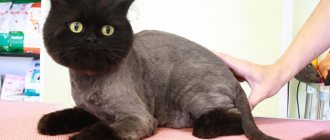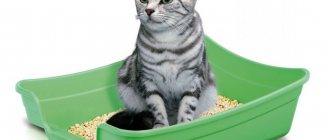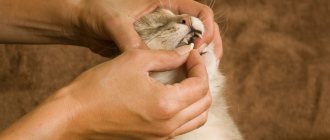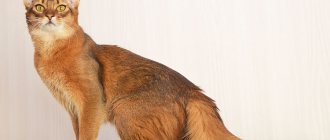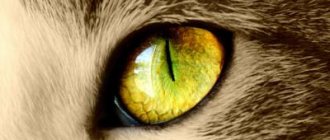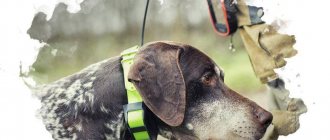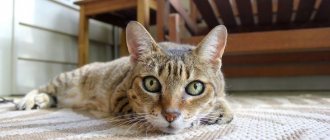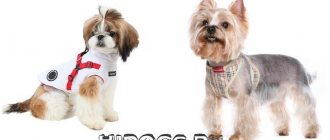Information about the material Category: Ecology Published: April 20, 2019
4.9583333333333 Rating 4.96
Cat grooming. Pet care. — 4.9 out of 5 based on 12 votes
Any animal is pleasant to look at if it is beautiful and well-groomed. Pets largely depend on the care of their human owners. A person helps his beloved pets tidy up their fur or feathers, claws and beaks.
What is grooming?
Initially, the term defined the animal’s self-care for itself. In the modern world, the word has received a different interpretation, since man took upon himself all the main concerns for those whom he managed to tame. Thus, grooming can be defined as a set of caring activities. Moreover, many people strongly associate the term exclusively with caring for a dog’s coat. This is wrong.
It includes two types of procedures:
- hygienic . This includes hair care, which consists of bathing, drying, combing, trimming and removing tangles. But at the same time, this also includes caring for the dog’s eyes, ears and teeth. Periodic hygiene is also part of grooming. Removing ticks that have already burrowed into the dog and treating wounds are a type of grooming;
- aesthetic . From the name it becomes clear that the procedures are aimed at improving the dog’s appearance - curly hair cutting, teeth whitening, tattooing, exhibition preparation.
Dog owners should remember that grooming is necessary for everyone.
But to what extent and in what form is up to the owner to decide.
What is this in general terms?
Grooming is a complex event that includes caring for the animal’s fur, ears, teeth and skin. In nature, grooming is widely developed. From birth, an animal acquires self-care skills; this ability protects its natural fur from harmful environmental factors. Cats and dogs, for example, groom themselves, parrots preen their feathers, and primates catch fleas. For many animals, grooming is one of the most important parts of life, allowing them to exist and strengthen bonds between relatives.
Types of grooming
It would seem that everything is clear with care procedures. However, we can distinguish types of grooming:
- hygienic – all measures that are necessary to maintain the health of the animal;
- professional - this type is resorted to under certain circumstances: during preparation for an exhibition, creating an image for a photo shoot, etc. In this case, you cannot do without a professional; it is better if he works only with one or two breeds. Such specialists will be able to cut the dog’s hair, emphasizing its natural beauty and grace, and bleach the fur with special compounds without creating a danger to the pet’s health;
- creative _ Most often, such a specialist is approached by those who want to create a unique and fashionable image for their dog.
If everything is clear with the frequency of hygienic grooming - such procedures are carried out at least once a week, then with a haircut the issue is complex. It depends on the condition of the coat, its length and tendency to form tangles. In this matter, it is better to trust a specialist who can select special equipment that you can use at home between trips to the salon.
Creative grooming
If everything is clear with traditional types of grooming (pet, professional), then creative grooming deserves more attention.
This is a real art, which not every specialist masters, since, in addition to professional qualities, he must have considerable imagination and artistic talent.
Creative grooming, of course, sometimes goes beyond all limits. But here the master clearly tried to make the dog positive
The most popular ideas are cutting patterns and pictures on the pet's body, creating tattoos, pedicures, dyeing wool, piercings and decorative jewelry.
The prices for these services are quite high, but it is definitely worth it.
Important! An interesting fact is that the now popular “a la lion” haircut actually began to be used in the middle of the last century on poodles.
Cutting patterns occurs as follows:
- First, a pattern or picture is thought out. A true professional can complete almost any idea - from a popular foot to an entire painting.
- Next, special paints are applied to the skin.
- Trimming. Large pictures require a lot of time and effort.
Tattoos on the body of an animal look no less creative, although they are much easier to do. Transfers are simply applied to the prepared skin of the pet.
They are worn for about 3-4 weeks and are completely harmless to the dog’s health.
Golden “socks” on the paws, decoration on the neck and patterns in the form of leaves – what’s not to say about the autumn mood?
Important! Initially, shiny and iridescent pictures were popular. Now tattoos that glow in the dark have burst into fashion.
Dog pedicures are far from new in pet salons. For this purpose, special grooming cosmetics are used.
For example, the varnishes used to cover a dog’s claws do not contain solvents and are therefore safe for health.
And what? Bright colors are in fashion now
Piercing is a new procedure, but has questionable reviews.
After all, it would seem that ear piercing is harmless and is suitable for almost all breeds, but the animal can injure itself if the jewelry gets caught in a corner or some object.
The cheapest option is to use various decorations. The most common examples are bows, braids, and hairpins on Biewer Yorkies .
Salon or home conditions?
Many owners think about this question, giving themselves many reasons for and against. If you decide to use the services of a professional groomer, then you don’t have to go or go to the salon. In the modern world, a specialist can come directly to your home to “beautify” your dog in a familiar environment. But even having a groomer come home has its downsides:
- Any dog perceives its home as a territory that needs its protection. A stranger may cause a negative reaction;
- in a home environment it is difficult to create the same workplace that a master has in a salon. This includes washing the dog in a special bath, and a convenient table for grooming with fixation of certain positions;
- need for cleaning.
Of course, there remains the possibility of caring for the dog yourself. If a show career or a hair-to-hair look is not your dog's thing, you can cut it yourself. Well, regular grooming shouldn’t cause any problems at all. If cutting a haircut is difficult, visit the salon and watch how the hairdresser does it.
Salon grooming is distinguished by quality and convenience. In trusted places with an impeccable reputation, there are specialists who can persuade even the most intractable “client” to have their unloved nails trimmed. Of course, such professional services are not cheap.
Additional items
They are usually used in conjunction with complex haircuts. For example, a fairly common option is when long-haired dogs are cut, even dyed in a special way, leaving strands of fur on the back for braids or ponytails, which are decorated with various additional accessories:
- Rubber bands.
- With hairpins.
- Rhinestones.
Decorative elements that help create a certain image. For example, portray a cartoon character.
Most often, such additional elements are used for unusual everyday decoration by owners of decorative dogs: Yorkies, Pekingese, Spitz, Shih Tzu.
What do you need to groom dogs at home?
Even if you regularly visit the salon, you need to know the main points about home grooming. You should not overpay for hygienic care; being able to perform manipulations is the responsibility of the dog owner.
Grooming Tools
At home you need to have:
- a comb with iron teeth, a slicker brush, a mitten with a silicone brush. The set of tools for combing depends on the pet's coat;
- scissors of different sizes with blunt tips so as not to injure the dog;
- high-quality sharp nail clipper, selected according to the diameter of the animal’s claws;
- device for cutting tangles. This type of tangle cutter is also useful in cases where the dog picks up a burdock;
- cotton pads, napkins and other material that will be on hand for treating eyes and ears;
- specialized sprays and lotions for hygiene;
- shampoo selected according to age, coat type and color. You can purchase dry shampoo or powder that allows you to clean your hair without water;
- toothpaste and brush, tartar remover.
Such a set of tools and tools should be at hand. After all, a dog can become dirty at any moment of the day or night.
Features of grooming cats of various breeds
Grooming cats and cats is a way to maintain the health and appearance of your pet in excellent condition. Grooming is a set of hygiene procedures that allow animals to develop properly and be in a good mood. In addition, grooming is necessary when the cat develops skin diseases, in the presence of small parasites, in hot weather, or to remove mats. Grooming procedures include:
- bathing using hypoallergenic shampoos and conditioners;
- combing wool using special combs and brushes;
- cleaning the ears with cotton swabs and teeth using medicated pastes and rinses;
- washing the eyes with antiseptic and other means;
- trimming nails using nail clippers and nail scissors;
- haircuts, including exclusive and model ones.
The procedures performed by the groomer have some peculiarities. The master knows that the animal’s head should not be cut. You should not trim the hair around the ears, as the whiskers may be damaged. During the procedure, the groomer can identify incipient dermatitis, deficiency of vitamins and minerals. The psychological component is important in the work of a master: cats do not like hygiene procedures, you need to be able to find an approach to pets.
Grooming is stressful for a dog or cat. It should be done in case of emergency, when there are external indications (long hair, interfering curls).
Types of haircuts
There are a huge number of dog breeds in the world, and types of haircuts have been developed designed to highlight the beauty and hide the dog’s shortcomings.
Types of haircuts:
- trimming - even cutting of the coat over the dog's body;
- stripping _ For breeds with hard coats that hardly shed. The “old” fur is plucked by a groomer. Stripping is carried out for schnauzers, terriers, huskies, etc.;
- Rolling is a subtype of stripping. Feature: dying fur is removed not at once, but gradually. This type of haircut is carried out once every two weeks;
- top note . Everyone knows a hairstyle with an elastic band or a hairpin, performed in the form of a ponytail on the head. A striking example is the Yorkshire Terrier;
- thinning _ Creates smooth transitions between long and short hair. For example, this technique is used when preparing for a cocker spaniel exhibition.
Preparing for an exhibition will require the groomer to have knowledge, skills and tools. It is quite difficult to perform these types of haircuts at home.
Types of haircuts
One of the main processes in grooming is cutting. They can also be different and intended for different situations. Highlight:
- Trimming, which is carried out with scissors or a machine. Depending on the length chosen, there are clippervec (very short haircut) and flatvec (hair is cut in areas defined by the standard).
- Stripping involves plucking out old fur. It is mainly carried out on those breeds that have a hard coat (for example, miniature schnauzers , Yorkshire terriers ). This procedure requires a special knife.
- Rolling is considered a type of stripping. Recommended for those pets who constantly participate in exhibitions.
- Hygienic grooming is necessary for all breeds. It involves cutting individual areas - the ears, near the eyes.
Each breed has its own standards. If a groomer trims your pet incorrectly, he will not be allowed to participate in a professional show.
Important! Experts recommend taking into account seasonality: in summer, it is best to cut your dog’s hair shorter so that the coat requires minimal care. In addition, with a short haircut it is much easier to notice ticks and other insects that can harm your pet.
Main stages of grooming
Care consists of several mandatory stages:
- Carefully comb the animal's fur. Everything that gets in the way is removed: tangles, dirt, old hairs, etc.
- A haircut. For a show dog, the type of haircut is selected according to the breed, styled according to the standard. For a pet with no prospects, any haircut can be performed.
- Hygienic treatment of eyes, ears and teeth.
- Nail trimming. Often this is the point that causes difficulties.
- Cleaning the anal glands.
- Water procedures. Washing the dog is done with special shampoos, without using human cosmetics.
- Dry thoroughly. At home they use a towel and a hairdryer, and in the salon there is a compressor.
Mastering the techniques
The simplest type of care , trimming cats' claws, can be done yourself using nail clippers. We do not cut the claws short so as not to injure the blood vessels, leaving 2 mm to the sensitive area. In addition to nail clippers, you can try using nail clippers, regular scissors, or a guillotine trimmer. In addition to the above equipment, prepare a file for filing the edge of the claw (or an emery block), cotton pads and hydrogen peroxide in case of injury. To prevent the latter from happening, fix the position of the animal by pressing it to a soft base and keeping its paws pressed to the body.
Hold the paw to be trimmed with your left hand, press the pad in the center to extend the claws. Since the claws are transparent, the blood channels are also obvious; in the case of dark claws, trim no more than 1-2 mm at a time without damaging the nerve endings. Hold the tool strictly perpendicular to the claw, this will reduce the risk of plate delamination. Trim in one step, when you get the hang of it, you will spend no more than a couple of minutes on the entire correction. Next, treat the edge of the claw with a nail file - this will make both the cat and the furniture more comfortable.
For the first time, you can watch a specialist work, and then you can do it yourself. Trimming for cats is an individual procedure, its frequency is determined by many factors (color, gender, body characteristics, pet’s lifestyle). Nowadays, special anti-scratch pads made of silicone are also common, they are of different colors, they will decorate your pet, and at the same time protect the furniture, you and your family from damage by the clawed animal.
Another type of home grooming is bathing your pet. Before it, check your pet’s skin for various types of damage and, if any, postpone water treatments. Do not use “human” products; consult breeders or veterinarians about this.
Combing fur is also a type of home grooming. To comb out excess hair, it would be a good idea to buy a furminator or a trimmer for animals (a human clipper is not a suitable option). The animal's fur becomes neat, slightly trimmed, and neat in appearance. Grooming may also include caring for the ears, hair between the toes, genitals and anus.
When to start grooming your pet
It is better to start grooming breeds with long hair, especially decorative ones, when they reach 3 months of age. If your dog develops tangles before this age, it’s worth starting even earlier. If the owner cannot cope with the task, it is better to contact the salon.
Painful combing of tangles at home can forever turn the dog away from such procedures.
It is better to start grooming and accustoming your puppy to it in a salon environment. If the owner does not have sufficient experience, cutting a baby's hair can result in injury, and cutting nails can result in blood poisoning.
Kinds
Depending on the breed of the dog and its areas of application, financial capabilities and the imagination of the owners, the type of grooming that is used at one time or another depends.
There are the following types:
- Hygienic. Necessary for all pets, regardless of breed, size and type of coat. Hygienic grooming consists of trimming the coat, cutting out mats, combing, trimming or filing nails, as well as cleaning the ears and washing the eyes. Many of these procedures are carried out at home if the owner does not want to visit the salon.
- Aesthetic. Typically used for show dogs. Aesthetic treatments are most often carried out in beauty salons for animals. Professionals have the necessary set of tools and special detergents.
- Creative. A new direction in the world of cynology. It consists of giving the animal uniqueness. Ways to make your dog stand out from thousands of others: tattoos on the skin of bald pets, piercings (with rhinestones, diamonds, gold jewelry), an original haircut, braiding, curling, unusual painting (coloring, highlighting, tinting), painting nails with bright varnish.
For an ordinary pet, hygienic grooming at home will be sufficient if the owner has minimal skills in such procedures. Show dogs, especially those with long hair or those with a mandatory standard of haircuts, will need professional, aesthetic grooming.
Ear care
Once a week, the dog's ears are cleaned.
To do this, you will need hydrogen peroxide or vegetable oil, cotton swabs or swabs.
If the hairs grow inside the ear, getting into the ear canal, then they are cut off so as not to prevent the wax from coming out.
The long ears of some pets fall into the bowl when feeding; in this case, they must first be secured to the back of the head with an elastic band so as not to get dirty.
Wax or dirt collected inside the ear can be easily removed with a swab (cotton pad) soaked in peroxide, or a cotton swab (for mini breeds).
Nail care
Necessary procedures include trimming claws and long hair between the toes (not for all breeds).
If the wool is not cut, it will absorb dirt, water, and reagents on the street, and this leads to fungal diseases or irritations. Neatly trimmed paws are much more convenient to wash or wipe after walks.
Long claws interfere with the pet's walking, change their gait, and lead to inflammation when they grow into the fingers.
Dog nail clipper
The claws are trimmed with a special nail clipper with a sickle or guillotine mechanism.
Sometimes filing is enough - if the dog moves a lot on the asphalt, then the claws are sharpened on it. If the pet reacts poorly to nail trimming, then they limit themselves to frequent filing, preventing them from growing too much.
A dog's nails are not completely hollow; their core extends at least to the middle of the claw, so trimming is done carefully. If the claws are light, then the pink core is clearly visible in the light.
Trimming black claws is very difficult; you need to act very carefully, otherwise bleeding will begin and the dog will always be afraid of it because of the pain caused. Hydrogen peroxide will help disinfect the wound. But it’s better to entrust this procedure to a groomer, at least for the first time.
Teeth cleaning
If you don't brush your dog's teeth, over time this will lead to inflammation of the gums, the appearance of tartar, caries and premature loss of chewing functions.
Regularly (at least once every 2 days) you need to brush your teeth with a special brush that follows the shape of the jaw and a paste that you can swallow.
Special brush for cleaning dog teeth
Pet stores sell special hard treats (compressed meat or fish), which when chewed by the animal, automatically cleans its teeth.
In advanced cases, surgery to remove the stone has to be done in veterinary clinics under general anesthesia.
Six and skin care
There are no uniform rules for caring for dog hair; they depend on the breed or its variety.
General procedures for caring for hair and skin: hygienic and antiparasitic washing, cutting out mats, cutting the whole body or individual areas, edging the uniform.
Let's take a closer look at these procedures.
Washing the dog
Antiparasitic washing is used when necessary: when parasites are noticed in the fur or there is a suspicion of their appearance (after an unauthorized walk with stray flocks, or the dog itches or chews itself). Use special shampoos for fleas and ticks.
On the topic: when should you bathe a puppy for the first time?
Hygienic washing is used after contamination or in accordance with washing recommendations for a specific breed.
So, some representatives can be washed at least every week (lapdogs, poodles, papillons).
In other breeds, the coat does not need frequent washing.
For example, most northern dogs (huskies, samoyeds, huskies) have hair that is capable of self-cleaning, because sled dogs or hunting dogs in their natural habitat never see shampoo in their entire lives. Their fur has virtually no dog smell. For such dogs, it will be enough to wash them 1-2 times a year, before a show or after heavy soiling during a walk.
When washing, they do not use human shampoos, but special care products for a specific type of fur.
After washing, the animal must be dried thoroughly; it should not be taken outside until completely dry. If your hair is long and thick, then you should use a hairdryer. There are some breeds that require a hair dryer. For example, the Hungarian Shepherd's fur is twisted into tight cords; without a hair dryer it will take 3-4 days to dry.
Hair cutting
Cutting out mats when they form is mandatory; they not only spoil the appearance of the pet, but also interfere with combing, washing, and observing the skin. Mats appear on any part of the body; if there are a large number of them, only a general haircut of the dog will help.
Shape edging is applied to certain breeds, most often before participating in show programs, photo shoots, and dog shows. This procedure is indicated for Maltese or French lapdogs, Bichon Frize, and poodles.
Depending on the tools and types of equipment used, the following types of haircuts are distinguished:
- Clippercut - a haircut with a clipper almost to zero. They cut either the whole body or just a part; along the hairline or against it; hand or power tools.
- Flatvec – cutting wool to one length, most often short. Cut with scissors or a machine.
- Blending (leveling) – smoothing the transitions from long to short hair. This is done with thinning scissors.
- The top note is styling long hair with hairpins, bows, and elastic bands. Used for decorative breeds, especially if the bangs fall into the eyes.
- Creative haircuts are original hairstyles that do not fit into breed standards.
- Trimming (stripping) is the removal of dead hairs with a special knife, mainly in wire-haired breeds. So, in terriers, schnauzers, and long-haired collies, the hairs die, but do not fall off. This spoils the overall appearance and leads to skin inflammation.
- Rolling is a type of trimming in which dead hairs are not removed all at once, but gradually, at time intervals. This allows show animals not to immediately lose their hair volume.
- Placking is the manual plucking of dead hairs (with the index finger and thumb).
Any haircut, except with a clipper “to zero”, is a labor-intensive and time-consuming task. Therefore, many owners trust this procedure to professionals.
Some animals do not require any grooming services (smooth-haired or sledding breeds, shepherd dogs), but they also need regular brushing.
After a haircut, show dogs also receive styling.
What dogs need grooming?
There are categories of dogs that need grooming:
- pets participating in exhibitions;
- dogs of decorative breeds, whose owners strive to give them an attractive appearance;
- long-haired breeds whose hair is prone to matting and matting;
- Wire-haired breeds whose coat requires trimming to ensure the shedding process.
But the usual hygiene procedures included in the concept of grooming are needed by all dogs without exception.
What is creative design?
The most radical method of grooming. I am not a fan of this direction, but I have nothing against it. Such actions will not cause any harm to the dog, which means it makes no sense to prohibit such things.
So, creative grooming of dogs is giving it an unusual and unusual appearance for this breed.
For example, a good example of such creativity is the Poodle's lion haircut. Moreover, such an option is no longer considered creative, it has become so familiar. Let's see what types of creative grooming are currently shared.
Who doesn't need to be cut?
Dogs can be divided into two categories based on coat type:
- with undercoat – trimming and shaving;
- without undercoat - it’s better to just comb it out.
Dogs with a special type of coat - an undercoat with guard hairs - do not need to be trimmed. Moreover, cutting or shaving the fur can lead to negative consequences: the pet will lose the protection of the skin, the development of follicular arrest - a slowdown in hair growth, leading to baldness. These dogs include: husky, Samoyed, Sheltie, Chow Chow, Labrador retriever, German shepherd, Malamute, Spitz, Maltese and others.
Haircut frequency
The optimal frequency of trimming depends on the breed of cat: they differ in the length, thickness and speed of hair growth.
Most often (up to four times a year) long-haired breeds need grooming: Persians, Ragdolls, Siberian and Angora cats, Maine Coons. Cats with medium-length hair, for example, British and Scottish Fold, need to be cut once or twice, preferably before the warm season.
Unscheduled haircuts are required if mats have formed on the fur. They cause severe discomfort to the animal, tightening the skin and preventing air exchange, which can create a favorable environment for the development of skin diseases.
Alternatively, you can trim the tangles as they appear, but this method has two significant disadvantages: firstly, there is a risk of accidentally injuring the cat’s skin, and secondly, it can cause damage to the cat’s appearance.
FAQ
Those who are just planning to visit a grooming salon and have difficulties with their dog have a number of questions.
Is it possible to use anesthesia for grooming?
Yes, such a possibility exists. But performing the procedure under anesthesia will cause great harm to health: allergies, psychological problems, death. Therefore, experts advise using a sedative and a dog immobilization system. Suitable for large aggressive dogs.
Are there any special features of grooming a large dog?
Features are dictated by the size of the dog: a larger bath, more cosmetics, and more work from the groomer are needed. Of course, the cost of services for a canine giant will be higher.
What is the best towel to dry your dog?
The best option is microfiber. It very quickly absorbs water in large quantities, the structure allows you to wipe away dirt.
Is conditioner necessary for grooming?
Yes, hair treated with balm does not get dirty longer and dandruff is less likely to form. Relieves dryness and dermatitis.
Features of the procedure for dogs and cats
Grooming is not just the sole privilege of dogs. Cats also have their own personal stylist and cosmetologist. But the procedures for cats and dogs are different. After all, by their nature these are completely different animals. What should you consider when working with cats?
- Disobedience. The first and most important difference is that cats do not obey commands. A trained dog just needs to give a signal with a voice or a gesture, and it will sit relatively still while it is being groomed. This trick will not work with a cat, because she is a famous “fighter” for her freedom and independence. It is also more difficult to restrain than a dog. The only option is a leash with a figure-eight knot, but here you should also be careful, because the structure of a cat is much more fragile than that of a dog.
- Unpredictability. A dog is a more manageable animal. You can always determine your mood by it. “Cat language” is almost impossible to count. Therefore, the groomer must always be on guard.
- The master must defend himself. The cat's reaction speed is known to be very high. She is armed with claws and sharp teeth. Therefore, the master is forced to use protective equipment in his work. They can also be useful for dogs, but much less frequently.
- Increased flexibility. Cats are incredibly flexible. Dogs don't have that flexibility. For example, it is easy to move a cat's front paw up and even behind its head. Therefore, trimming the underarm area of cats is easier.
- Thin skin. Cats have thinner skin than dogs. When cutting, you need to take this nuance into account.
- Oily hair. Many cat breeds have much oilier fur than dogs. Regular detergents will not work for them. You need special degreasing pastes and shampoos.
- In some cases (first visit to the salon, nervous nature), cats are given sedatives before the procedures. Dogs do not need sedatives.
- More complex breed standards. Cats have much more exhibition systems than dogs. According to different systems, standards for cats may differ.
Features of cat grooming:
- Long-haired breeds. Cats with long hair need to trim excess hair between the toes and under the tail. Long-haired pets are brushed every day (in some cases, twice a day).
- Short-haired breeds. With them, care becomes easier - comb them once or twice a week. They bathe when the need arises (maximum interval – once every three months).
- Breeds without hair (like the Sphynx). Hairless cats should take baths regularly. When bathing, it is important to use shampoo with a pH level of 5.5, no more. They then need a massage with a soft bristle brush.
Regular hygiene for most breeds consists of the most basic procedures. Once a week or even a month, cats have their ears cleaned. The eyes are systematically wiped to remove secretions. Teeth are cleaned of plaque and tartar.
Features of dog grooming:
- Dogs need to be bathed much more often than representatives of the cat family - once or twice a month, at least.
- The coat needs to be brushed every day. This reduces the chances of tangles forming.
- Haircuts are done 1-2 times a month. In summer, it is advisable to shorten the fur more so that the pet can more easily endure the heat.
